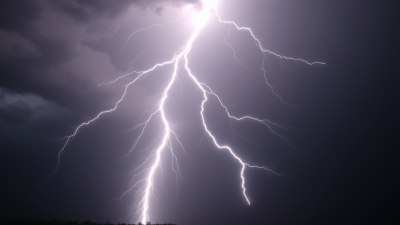Why You See Lightning Before You Hear Thunder
Understand why lightning flashes before thunder roars, exploring sound and light speed differences and storm science.

Image created with Flux Schnell
When a thunderstorm rumbles in the distance, it’s common to see a sudden flash of lightning before you hear the accompanying sound of thunder. This phenomenon has fascinated people for centuries and provides an excellent introduction to basic physics principles and meteorology. Understanding why lightning precedes thunder requires exploring how light and sound travel differently through the atmosphere.
Lightning and Thunder: A Brief Overview
Lightning is a giant spark of electricity in the atmosphere between clouds, the air, or the ground. It is caused by an electrical discharge that occurs when static electricity builds up within storm clouds. Thunder is the sound produced by this sudden discharge of electricity. As the lightning bolt heats the surrounding air, the air rapidly expands and creates a shockwave we perceive as thunder.
Although lightning and thunder are produced almost simultaneously by the same event, they reach our senses at different times. This time difference is the key to why we see lightning before we hear thunder.
The Speed of Light Versus the Speed of Sound
The primary reason we see lightning before hearing thunder is because light travels much faster than sound. Light waves move at a speed of approximately 299,792 kilometers per second (about 186,282 miles per second) in the air, allowing them to reach our eyes almost instantaneously after the lightning occurs.
Sound waves, on the other hand, travel much slower. The speed of sound in air at sea level and at a temperature of 20 degrees Celsius (68 degrees Fahrenheit) is about 343 meters per second (or roughly 1125 feet per second). This means sound takes significantly longer to travel the same distance compared to light.
How This Affects What We Experience
Imagine a lightning strike happens one kilometer away. The light from the flash will reach you in just about 1/300,000th of a second, which to human perception is effectively instantaneous. The sound of thunder, however, will take approximately three seconds to travel this distance to your ears.
As a result, you witness the bright flash of lightning immediately but hear the thunder several seconds later. The farther away the lightning strike, the longer the delay between sight and sound.
Estimating Distance Using Lightning and Thunder
Knowing the difference in speeds gives a clever way to estimate how far away a storm is. A popular method is to count the number of seconds between seeing the lightning flash and hearing the thunder, then divide by three to estimate the number of kilometers away the storm is. For example, if you count six seconds between the flash and thunder, the storm is about two kilometers away.
In the United States and other countries using miles, dividing by five roughly estimates the distance in miles. This formula works because sound’s speed is about one kilometer every three seconds or one mile every five seconds.
Atmospheric Conditions Affecting Sound Propagation
The speed of sound isn’t fixed; it varies depending on several environmental factors including temperature, humidity, and altitude. Warmer air means sound travels faster because the air molecules move more quickly, facilitating the transmission of sound waves. Moist air also slightly increases speed compared to dry air.
Temperature gradients, where warmer air lies above cooler layers (called temperature inversions), can cause the sound to bend or refract, sometimes making thunder seem louder or audible over longer distances. Wind direction and speed also influence how thunder carries.
Variations in Lightning and Thunder Distances
Thunderstorms vary widely in size. Lightning can strike several kilometers away from the rain area of the storm, sometimes called "bolt from the blue." This means you could see lightning flashes from a storm elsewhere but may not immediately hear thunder if the strike is too distant. In some cases, you can see lightning but hear no thunder at all, known as "heat lightning," which actually is thunderstorm lightning too far away for the sound to reach you.
The Science Behind Lightning Formation
Within a storm cloud, strong upward winds called updrafts carry water droplets and ice particles upward. Collisions between these particles cause a separation of electrical charges within the cloud - negative charges tend to accumulate near the bottom, with positive charges near the top. This charge separation creates an enormous electric field inside the cloud.
When this electric field becomes strong enough, it overcomes the insulating properties of the air, generating a lightning discharge that can pass from cloud to cloud, cloud to ground, or within a cloud itself. The rapid movement of electrons forms the lightning bolt, carrying enormous currents and reaching temperatures hotter than the surface of the sun.
Thunder Generation: The Acoustic Effect of Lightning
Once the lightning bolt forms, it ionizes the surrounding air, turning it into a plasma channel. The air temperature in this channel can spike to about 30,000 Kelvin (around 53,540 degrees Fahrenheit), causing the air to expand explosively. This rapid expansion creates a pressure wave that propagates away from the lightning path as thunder.
The complex shape and path of the lightning channel affect the sound of thunder, causing variations in loudness, tone, and duration. Thunder often sounds like a rumble or a crack and can last several seconds due to echoes and the extended length of the lightning channel.
Perception of Thunder and Lightning by Humans
Human sensory perception plays a role in experiencing lightning and thunder. Our eyes detect light near-instantly, but our brains must interpret the incoming light and sound signals. Since the light arrives faster, the brain registers the lightning first.
Moreover, the distance between the eyes and ears is minimal compared to the distances of the storm, so the time difference from sensory reception is negligible. The significant delay is due solely to the travel speed difference between light and sound.
Safety Implications: Why Hearing Thunder Matters
Seeing lightning before hearing thunder is not just a curiosity but an important safety indicator. When you see lightning and then hear thunder shortly afterward, it suggests the storm is relatively close and potentially dangerous. Since lightning can strike miles away from the main storm, hearing thunder means the storm is within striking distance.
Safety guidelines advise that if you can hear thunder, you should seek shelter immediately to avoid being struck. The countdown method of estimating storm distance can help you decide when it’s time to move indoors.
Additional Phenomena Related to Lightning and Thunder Timing
Sometimes, especially during intense electrical storms, observers report seeing multiple lightning flashes and hearing varying thunder sounds. This happens because lightning bolts can take different paths and are located at different distances. The overlapping sounds create a complex auditory experience.
In some cases, lightning flashes may appear to flicker or pulsate, and the thunder can have a rolling, echo-like quality due to terrain, buildings, and atmospheric conditions reflecting and refracting the sound waves.
Technological Applications and Measurements
Modern meteorology uses sophisticated equipment to monitor lightning and thunder. Lightning detectors and sensors track the location and frequency of lightning strikes, providing real-time data for weather forecasting and safety warnings.
Acoustic sensors can detect thunder, but since sound travels slower and is affected by environmental noise, lightning detectors are typically more efficient for early warning systems. Additionally, remote sensing technologies including Doppler radar and satellite imagery complement ground-based lightning observations to track storm development.
Lightning in Different Cultures and Misconceptions
Cultural interpretations of seeing lightning before thunder vary. Throughout history, lightning and thunder have been associated with various myths, deities, and omen-like significance. Understanding the scientific explanation helps dispel superstitions and promotes better awareness of weather safety.
Some misconceptions include the belief that lightning and thunder are unrelated or that lightning comes from the ground upward, which while true in some instances, generally lightning originates within or from clouds.
In summary, lightning is the visible electrical discharge, and thunder is the resulting sound caused by the heated, expanding air. Because light travels at a speed roughly a million times faster than sound, our eyes perceive lightning almost instantaneously, while our ears receive thunder seconds later. The delay between lightning and thunder not only explains why we see one before the other but also enables estimation of storm distance and provides vital safety information.
Environmental factors affect the speed and clarity of thunder, and modern technology enhances our ability to monitor and understand storms. Recognizing these processes enriches our appreciation for the natural world and improves preparedness during thunderstorms.











